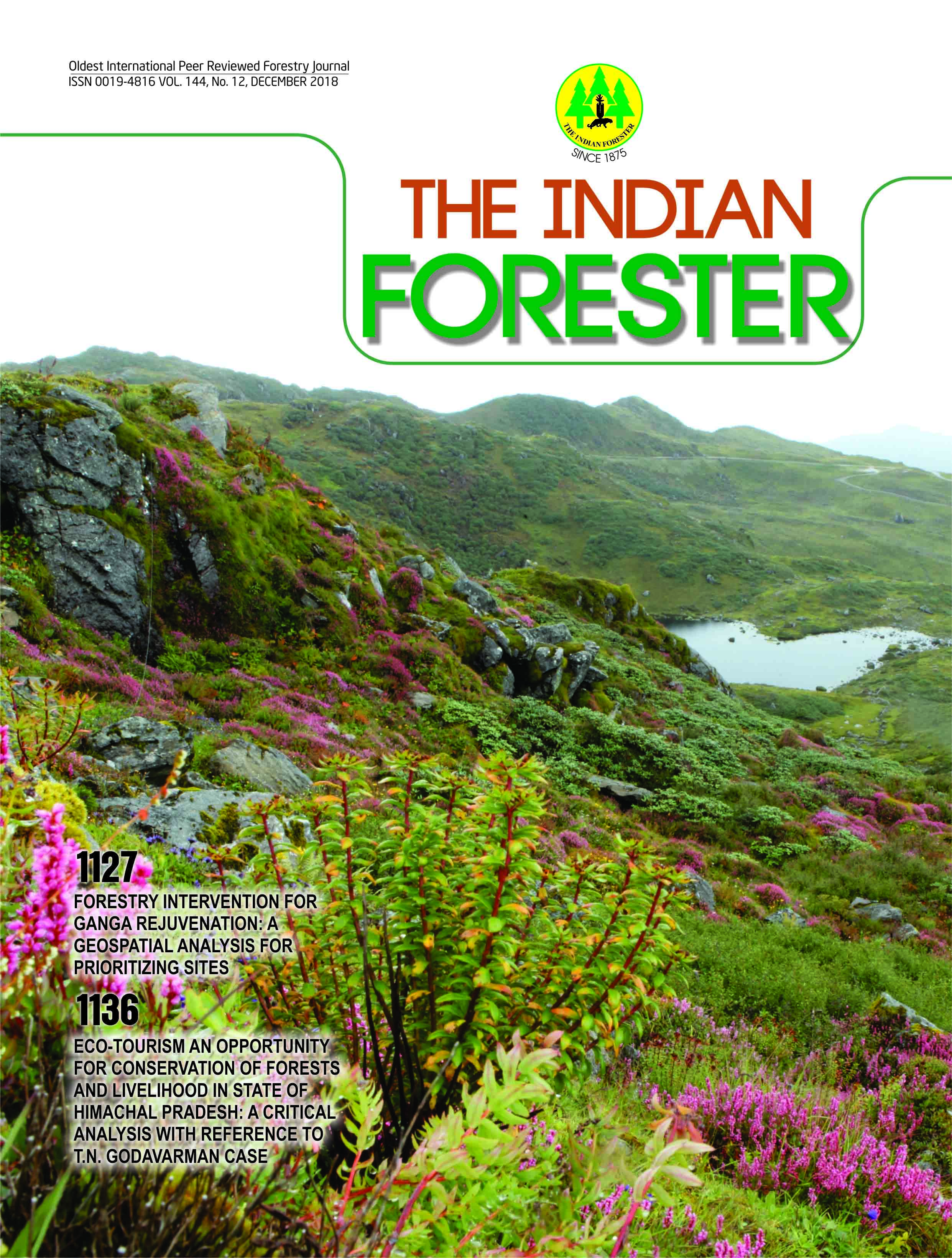Preliminary Study to Distinguish Sal in Rajaji Tiger Reserve through RS & GIS Technology
DOI:
https://doi.org/10.36808/if/2018/v144i12/141849Keywords:
Sal, Forest genetic resources, Supervised image classification, Remote sensing, Geographical information system, GeocoordinatesAbstract
The forest genetic resources are taped for species distribution, mapping, demarcation, assessment of genetic diversity, population genetics study and adoption of conservation measures for protecting the species for their sustainable utilization. In the present investigation, a methodology was developed to map Sal forest areas by preparing eco-distribution maps with the help of Remote Sensing (RS) and Geographical Information System (GIS) technology. Extensive surveys were conducted in Mohand and Sukh Blocks of Chillawali Range of Rajaji Tiger Reserve during 2016–17. To distinguish the Sal forest from dry mixed deciduous forest, both blocks were divided into 58 square grids (750x750m) and total area covered by each grid was 0.5628 km2. Three to four sample plots of size 6x6m were laid out; and 80 geo-coordinates were recorded in total of 24 grids, out of which 40 geo-coordinates belongs to Sal patches. Sixty per cent Sal patches were further used to train satellite imagery (LANDSAT–8) for supervised image classification. The Google Earth was used for better visual interpretation. Maximum likelihood rule was used to discriminate between Sal forest and dry mixed deciduous forest. Accuracy assessment was carried out with the other forty per cent Sal patches. Total area of both types of forest was found to be 28.14 km2 and area covered under Sal forest was 6.28 km2. The observed Sal dominated areas is in concurrence with the management plan of Rajaji Tiger Reserve but differed from the maps of Forest Survey of India, Dehradun.References
Anon. (2011). Forest type Atlas, Forest Survey of India Dehradun, India.
Anon. (2015). India State Forest Report, Forest Survey of India Dehradun, India.
Behera M.D., Srivastava S., Kushwaha S.P.S. and Roy P.S. (2000). Stratification and mapping of Taxus baccata L. bearing forests in Talle Valley using remote sensing and GIS. Current Science, 78(8): 1008-1013.
Champion H.G. and Seth S.K. (1968). A Revised Survey of Forest Types of India, Govt. of India Press, New Delhi.
Chaudhary K., Acharya A.K. and Khanal S. (2016). Forest type mapping using object-based classification method in Kapilvastu district, Nepal. Banko Janakari, 26(1): 38-44.
Das S. and Singh T. P. (2013). Mapping Vegetation and Forest Types using Landsat TM in the Western Ghat Region of Maharashtra, India. Inter. J. Computer Applications, 76(1): 33-37.
Darvishsefat A.A. and Shataee S.H. (1997). Digital Forest Mapping using of LANDSAT-TM Data, Iranian Natural Resources Journal, 50: 39-40.
Harne T. (1984). LANDSAT-aided forest site type mapping. Photogrammetric Engineering and Remote Sensing, 50(8): 1175-1183.
Nagamani K. and Mariappan V.E.N. (2013). Forest type mapping using remote sensing techniques. Asian Acad. Res. J. Multidisciplinary, 1: 104-114.
Rasaily S.S. (2012). Management Plan of Rajaji National Park. 2012-13 to 2021-22.
Shataee S.H., Kelenberger T. and Darvishsefat A. (2004). Forest types classification using ETM+ data in the north of Iran/ comparison of Object-Oriented with Pixel-Based Classification Techniques, XXth ISPRS Congress, Turkey.
Singh G., Padalia H., Rai I.D., Bharti R.R. and Rawat G.S. (2016). Spatial extent and conservation status of Banj Oak (Quercus leucotrichophoraA. Camus) forests in Uttarakhand, Western Himalaya. Tropical Ecology, 57(2): 255-262.
Tomppo E. (1992). Multi-source national forest inventory of Finland. Proceeding of IIvessalo Symposium on National Forest Inventories, Finland, 17-21, August 1992. The Finnish Forest Research Institute, Research Paper 444, 52-60 pp.
Williams J.A. (1992). Vegetation Classification Using LANDSAT TM and SPOT-HRV Imagery in Mountainous Terrain, Kananaskis Country, S.W. Alberta. Alberta recreation and Parks, Kananaskis Country Operations Branch.
URL 1. http://www.harrisgeospatial.com/docs/ SPEAR AtmosphericCorrection.html)
URL 2. https://blogs.esri.com/esri/arcgis/2013/07/24/bandcombinationsfor-landsat-8
Downloads
Downloads
Published
How to Cite
Issue
Section
License
Unless otherwise stated, copyright or similar rights in all materials presented on the site, including graphical images, are owned by Indian Forester.





